SUZUKI ALTO 2020 Owners Manual
Manufacturer: SUZUKI, Model Year: 2020, Model line: ALTO, Model: SUZUKI ALTO 2020Pages: 139, PDF Size: 2.22 MB
Page 101 of 139
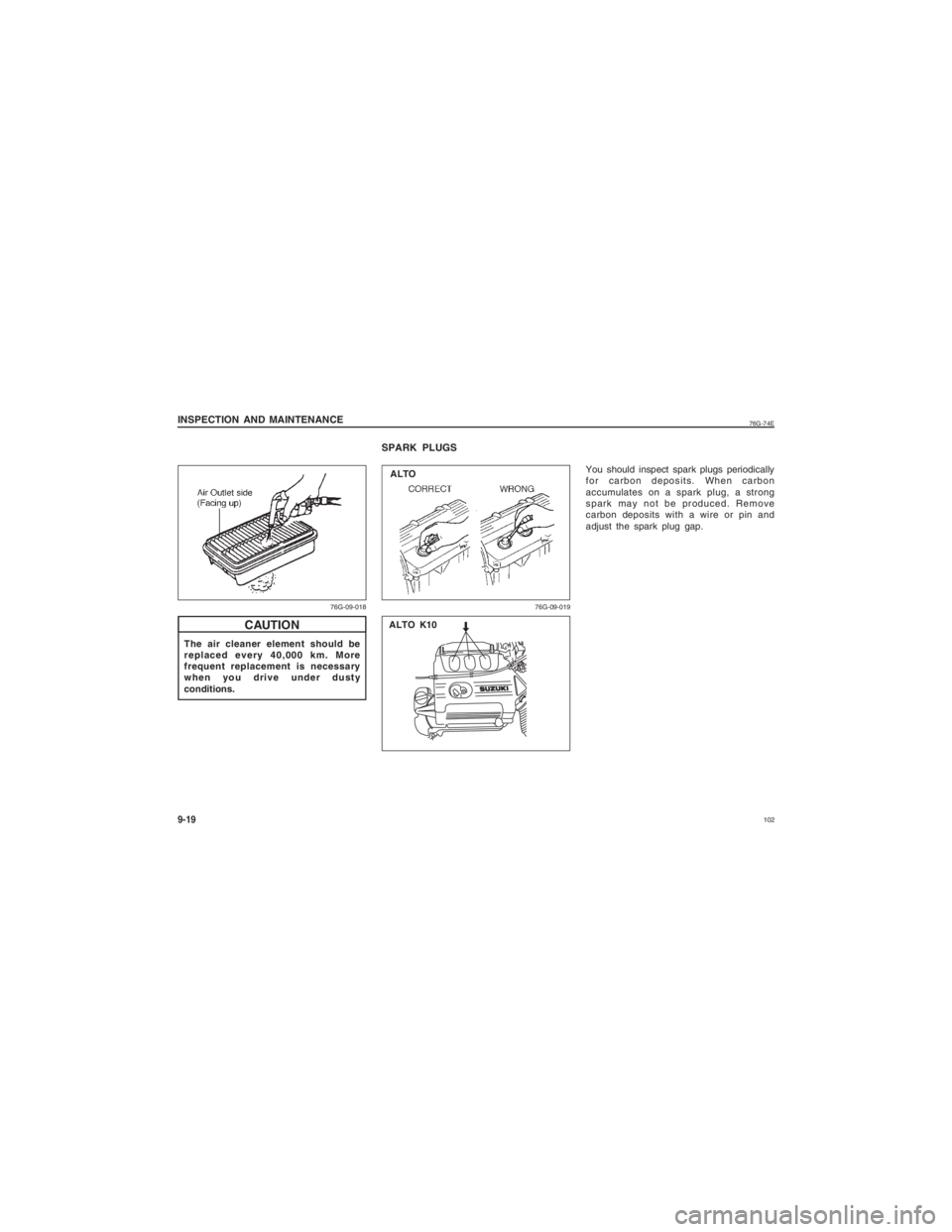
102
76G-74E
The air cleaner element should be
replaced every 40,000 km. More
frequent replacement is necessary
when you drive under dusty
conditions.
CAUTION
SPARK PLUGS
You should inspect spark plugs periodically
for carbon deposits. When carbon
accumulates on a spark plug, a strong
spark may not be produced. Remove
carbon deposits with a wire or pin and
adjust the spark plug gap.
76G-09-01876G-09-019
ALTO K10
INSPECTION AND MAINTENANCE9-19
ALTO
Page 102 of 139
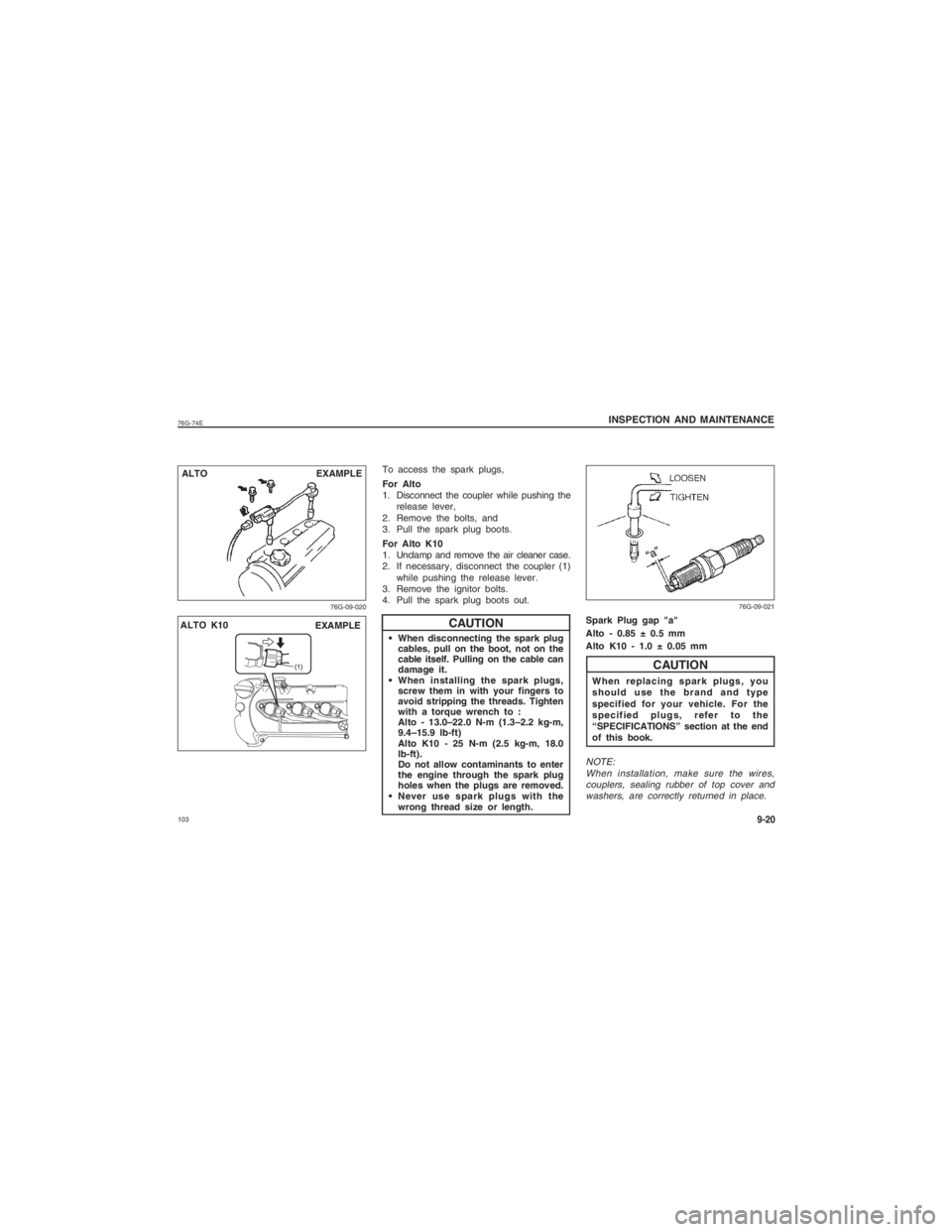
10376G-74E
76G-09-020
ALTO K10EXAMPLE
To access the spark plugs,
For Alto
1. Disconnect the coupler while pushing the
release lever,
2. Remove the bolts, and
3. Pull the spark plug boots.
For Alto K10
1. Unclamp and remove the air cleaner case.
2. If necessary, disconnect the coupler (1) while pushing the release lever.
3. Remove the ignitor bolts.
4. Pull the spark plug boots out.
CAUTION
76G-09-021
Spark Plug gap "a"
Alto - 0.85 ± 0.5 mm
Alto K10 - 1.0 ± 0.05 mm
INSPECTION AND MAINTENANCE
9-20
ALTO
EXAMPLE When disconnecting the spark plugcables, pull on the boot, not on the
cable itself. Pulling on the cable can
damage it.
When installing the spark plugs, screw them in with your fingers to
avoid stripping the threads. Tighten
with a torque wrench to :
Alto - 13.0–22.0 N-m (1.3–2.2 kg-m,
9.4–15.9 lb-ft)
Alto K10 - 25 N-m (2.5 kg-m, 18.0
lb-ft).
Do not allow contaminants to enter
the engine through the spark plug
holes when the plugs are removed.
Never use spark plugs with the
wrong thread size or length.
CAUTION
When replacing spark plugs, you
should use the brand and type
specified for your vehicle. For the
specified plugs, refer to the
“SPECIFICATIONS” section at the end
of this book.NOTE:
When installation, make sure the wires,couplers, sealing rubber of top cover and
washers, are correctly returned in place.
Page 103 of 139
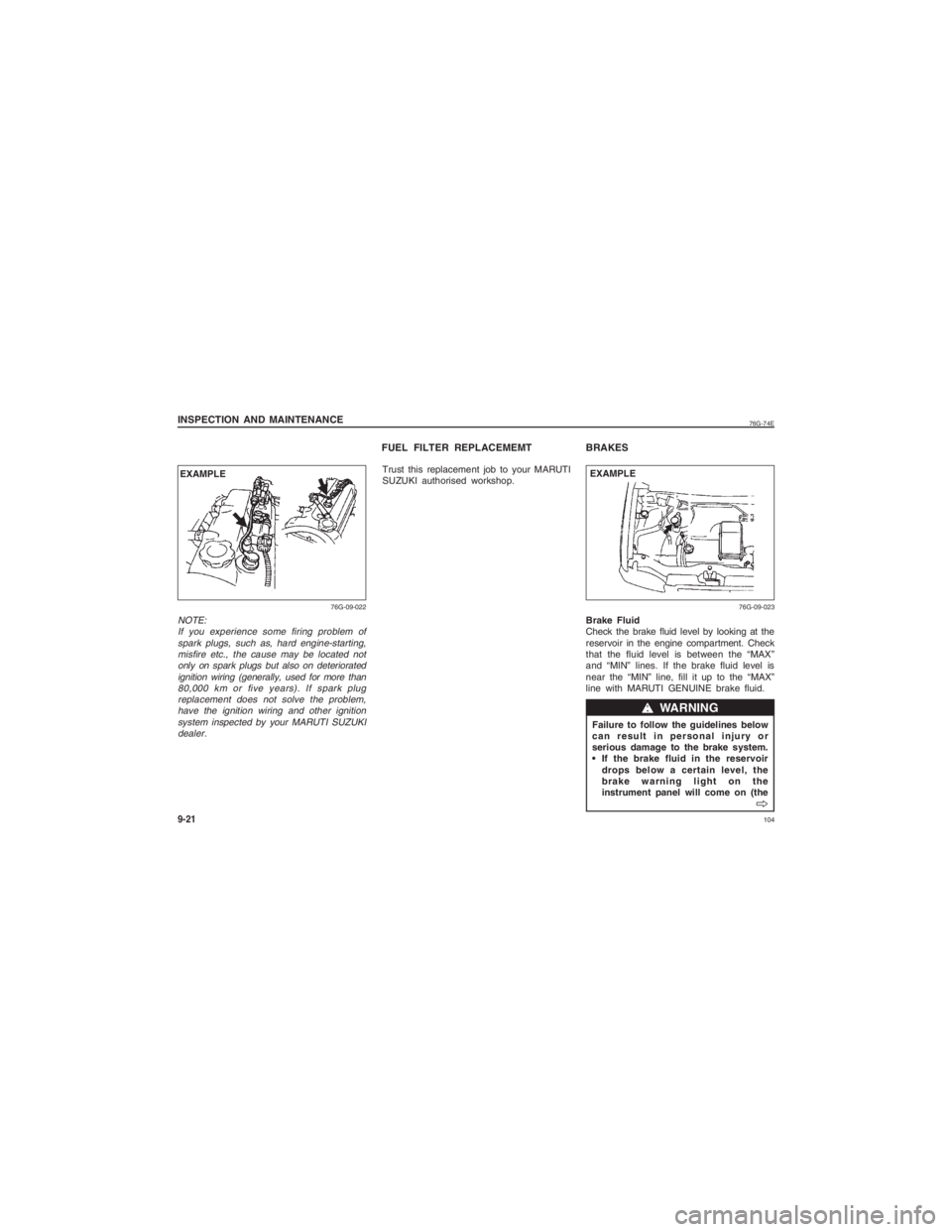
104
76G-74E
INSPECTION AND MAINTENANCE9-21NOTE:If you experience some firing problem of
spark plugs, such as, hard engine-starting,misfire etc., the cause may be located notonly on spark plugs but also on deteriorated
ignition wiring (generally, used for more than80,000 km or five years). If spark plugreplacement does not solve the problem,
have the ignition wiring and other ignitionsystem inspected by your MARUTI SUZUKIdealer.
76G-09-022
BRAKESBrake Fluid
Check the brake fluid level by looking at the
reservoir in the engine compartment. Check
that the fluid level is between the “MAX”
and “MIN” lines. If the brake fluid level is
near the “MIN” line, fill it up to the “MAX”
line with MARUTI GENUINE brake fluid.
Failure to follow the guidelines below
can result in personal injury or
serious damage to the brake system.
If the brake fluid in the reservoir drops below a certain level, the
brake warning light on the
instrument panel will come on (the
ww ww
w WARNING
VV
VV
V
76G-09-023
EXAMPLE EXAMPLE
FUEL FILTER REPLACEMEMTTrust this replacement job to your MARUTI
SUZUKI authorised workshop.
Page 104 of 139
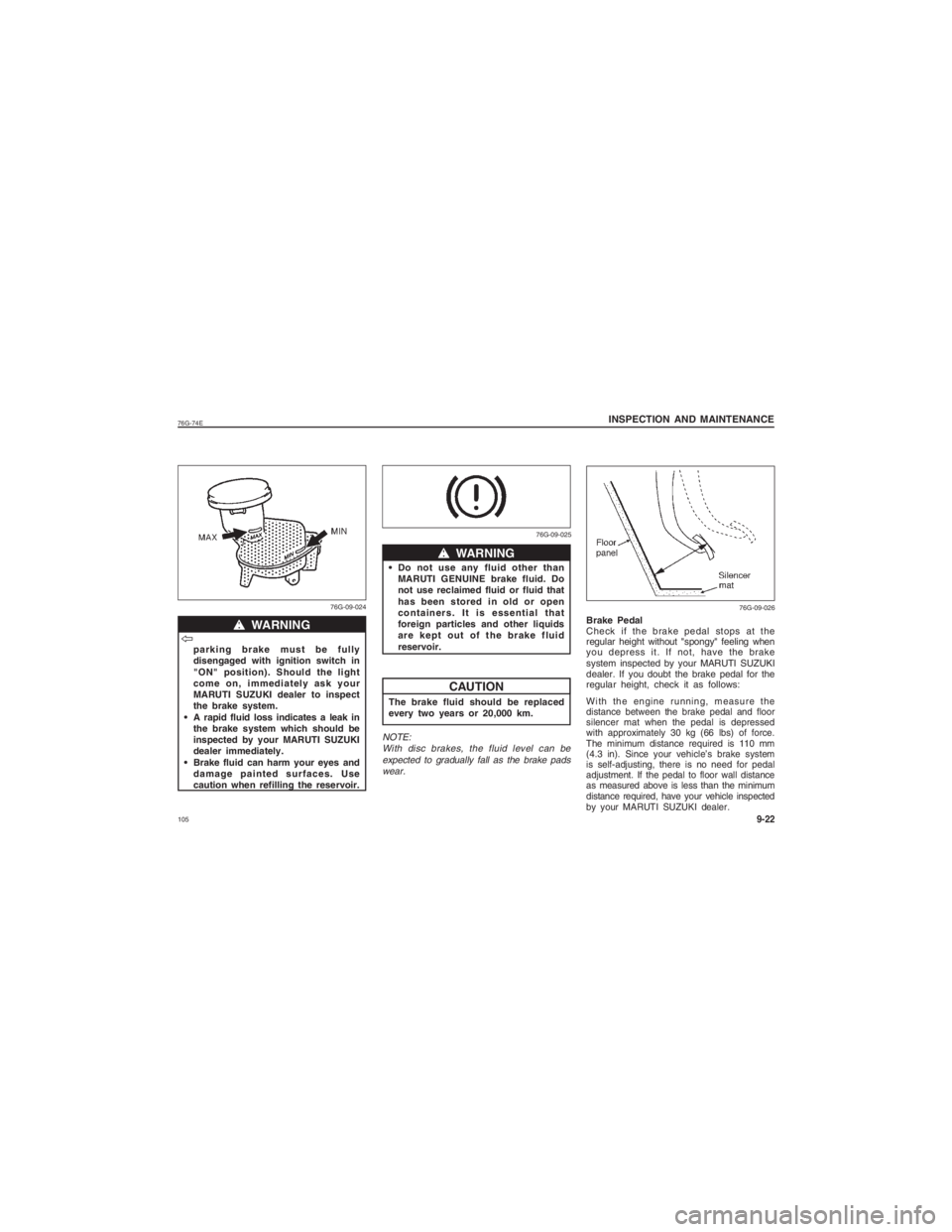
10576G-74E
parking brake must be fully
disengaged with ignition switch in
"ON" position). Should the light
come on, immediately ask your
MARUTI SUZUKI dealer to inspect
the brake system.
A rapid fluid loss indicates a leak in
the brake system which should be
inspected by your MARUTI SUZUKI
dealer immediately.
Brake fluid can harm your eyes and
damage painted surfaces. Use
caution when refilling the reservoir.
ww ww
w WARNING
VV
VV
V
76G-09-024
INSPECTION AND MAINTENANCE
9-22
Do not use any fluid other than
MARUTI GENUINE brake fluid. Do
not use reclaimed fluid or fluid that
has been stored in old or open
containers. It is essential that
foreign particles and other liquids
are kept out of the brake fluid
reservoir.
The brake fluid should be replaced
every two years or 20,000 km.NOTE: With disc brakes, the fluid level can beexpected to gradually fall as the brake padswear.
ww ww
w WARNINGCAUTION
76G-09-025
Brake Pedal
Check if the brake pedal stops at the
regular height without "spongy" feeling when
you depress it. If not, have the brake
system inspected by your MARUTI SUZUKI
dealer. If you doubt the brake pedal for the
regular height, check it as follows:With the engine running, measure the
distance between the brake pedal and floor
silencer mat when the pedal is depressed
with approximately 30 kg (66 lbs) of force.
The minimum distance required is 110 mm
(4.3 in). Since your vehicle’s brake system
is self-adjusting, there is no need for pedal
adjustment. If the pedal to floor wall distance
as measured above is less than the minimum
distance required, have your vehicle inspected
by your MARUTI SUZUKI dealer.
76G-09-026
Page 105 of 139
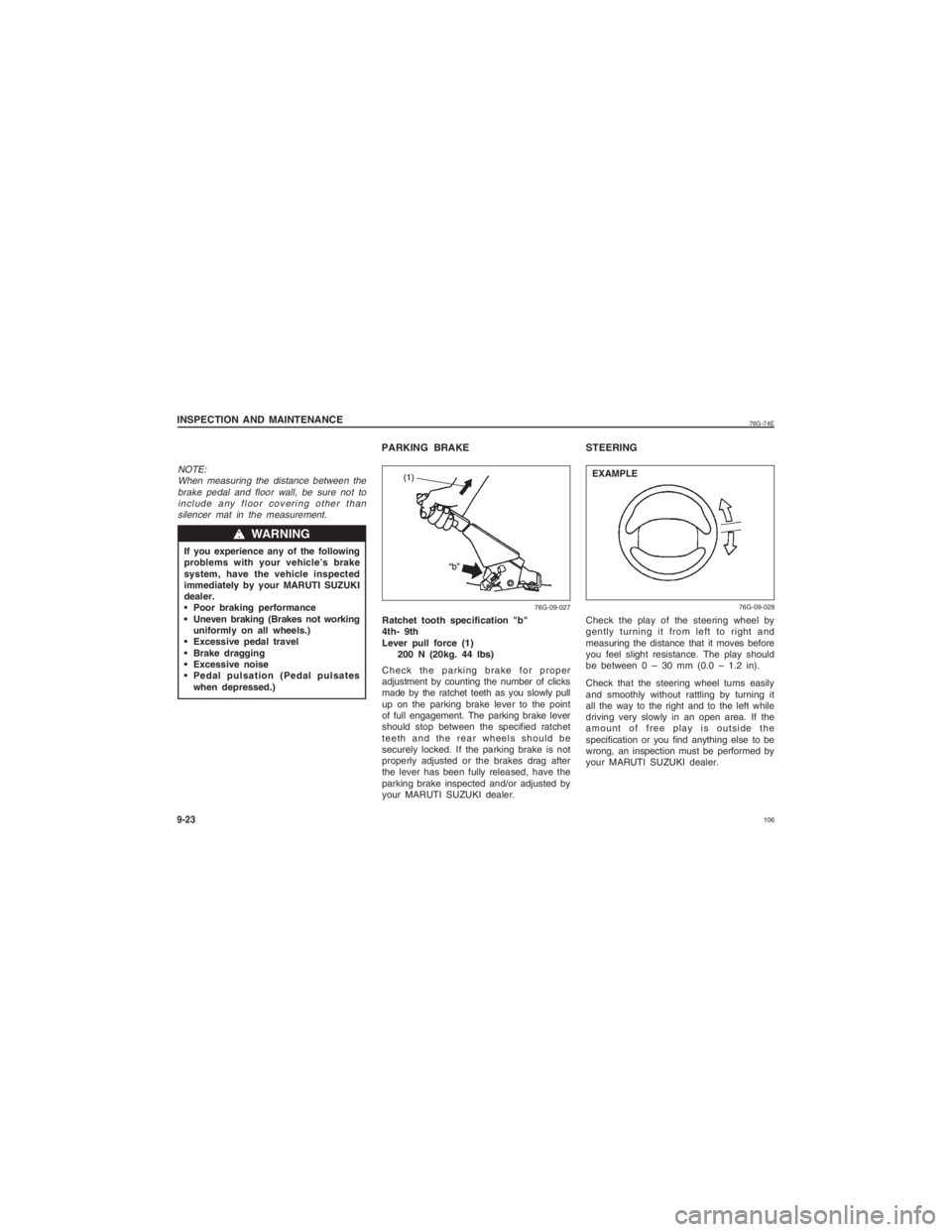
106
76G-74E
INSPECTION AND MAINTENANCE9-23NOTE:When measuring the distance between the
brake pedal and floor wall, be sure not toinclude any floor covering other thansilencer mat in the measurement.If you experience any of the following
problems with your vehicle’s brake
system, have the vehicle inspected
immediately by your MARUTI SUZUKI
dealer.
Poor braking performance
Uneven braking (Brakes not working uniformly on all wheels.)
Excessive pedal travel
Brake dragging
Excessive noise
Pedal pulsation (Pedal pulsates
when depressed.)
ww ww
w WARNING
Ratchet tooth specification "b"
4th- 9th
Lever pull force (1)
200 N (20kg. 44 lbs)
Check the parking brake for proper
adjustment by counting the number of clicks
made by the ratchet teeth as you slowly pull
up on the parking brake lever to the point
of full engagement. The parking brake lever
should stop between the specified ratchet
teeth and the rear wheels should be
securely locked. If the parking brake is not
properly adjusted or the brakes drag after
the lever has been fully released, have the
parking brake inspected and/or adjusted by
your MARUTI SUZUKI dealer.
76G-09-027
STEERINGCheck the play of the steering wheel by
gently turning it from left to right and
measuring the distance that it moves before
you feel slight resistance. The play should
be between 0 – 30 mm (0.0 – 1.2 in).
Check that the steering wheel turns easily
and smoothly without rattling by turning it
all the way to the right and to the left while
driving very slowly in an open area. If the
amount of free play is outside the
specification or you find anything else to be
wrong, an inspection must be performed by
your MARUTI SUZUKI dealer.
76G-09-028
EXAMPLE
PARKING BRAKE
Page 106 of 139
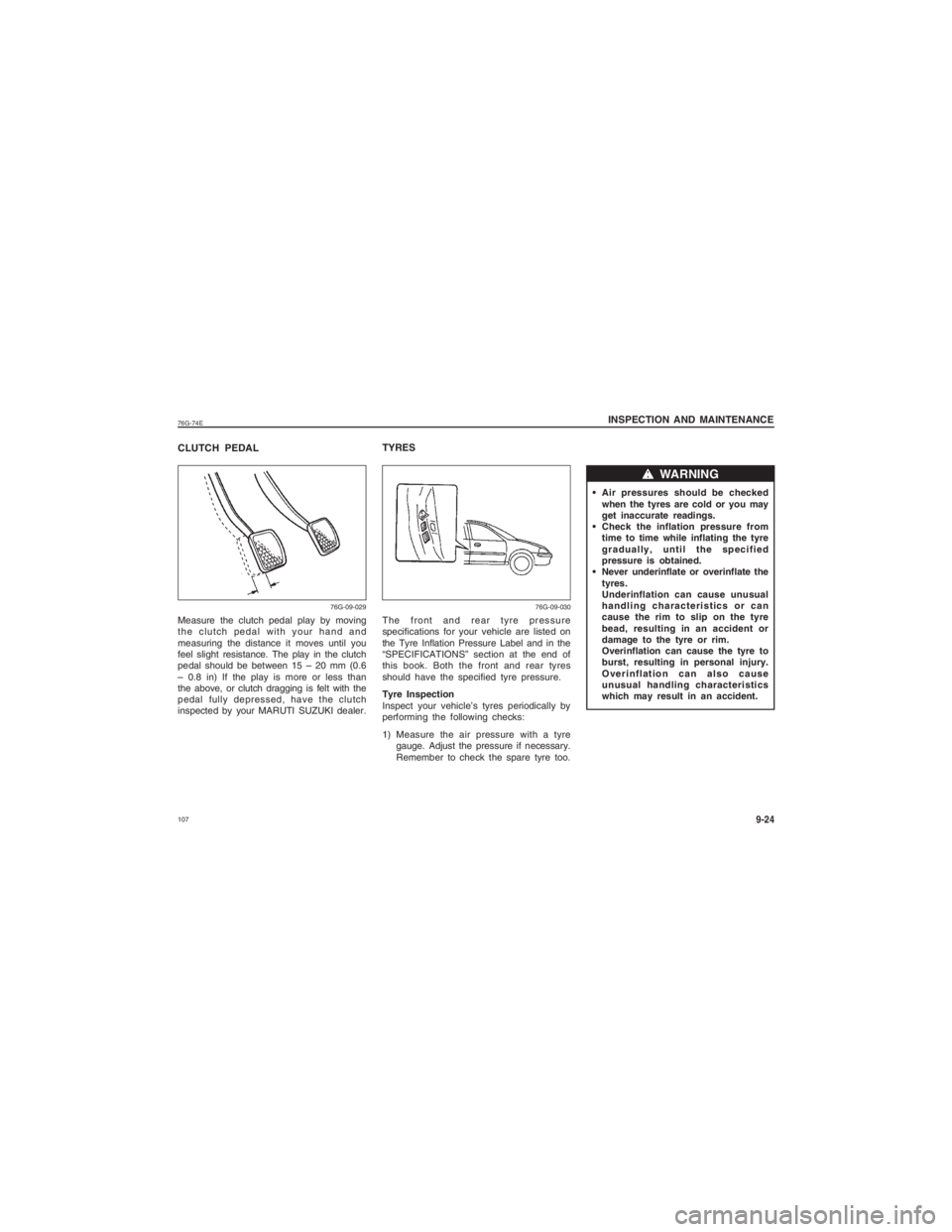
10776G-74E
9-24
INSPECTION AND MAINTENANCE
CLUTCH PEDAL
Measure the clutch pedal play by moving
the clutch pedal with your hand and
measuring the distance it moves until you
feel slight resistance. The play in the clutch
pedal should be between 15 – 20 mm (0.6
– 0.8 in) If the play is more or less than
the above, or clutch dragging is felt with the
pedal fully depressed, have the clutch
inspected by your MARUTI SUZUKI dealer.
76G-09-029
TYRESThe front and rear tyre pressure
specifications for your vehicle are listed on
the Tyre Inflation Pressure Label and in the
“SPECIFICATIONS” section at the end of
this book. Both the front and rear tyres
should have the specified tyre pressure.
Tyre Inspection
Inspect your vehicle’s tyres periodically by
performing the following checks:
1) Measure the air pressure with a tyre gauge. Adjust the pressure if necessary.
Remember to check the spare tyre too.
76G-09-030
Air pressures should be checkedwhen the tyres are cold or you may
get inaccurate readings.
Check the inflation pressure from time to time while inflating the tyre
gradually, until the specified
pressure is obtained.
Never underinflate or overinflate the tyres.
Underinflation can cause unusual
handling characteristics or can
cause the rim to slip on the tyre
bead, resulting in an accident or
damage to the tyre or rim.
Overinflation can cause the tyre to
burst, resulting in personal injury.
Overinflation can also cause
unusual handling characteristics
which may result in an accident.
ww ww
w WARNING
Page 107 of 139
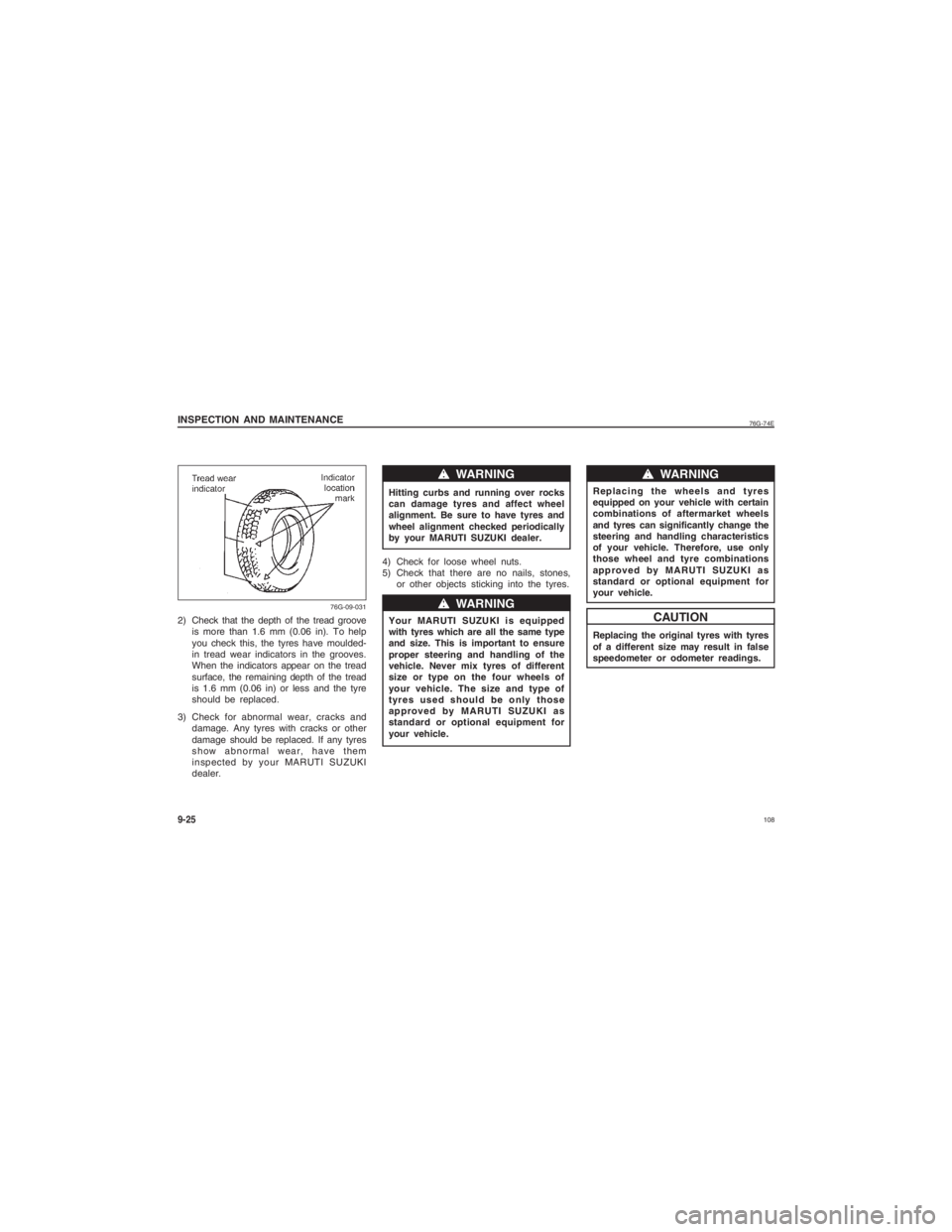
108
76G-74E
INSPECTION AND MAINTENANCE9-252) Check that the depth of the tread grooveis more than 1.6 mm (0.06 in). To help
you check this, the tyres have moulded-
in tread wear indicators in the grooves.
When the indicators appear on the tread
surface, the remaining depth of the tread
is 1.6 mm (0.06 in) or less and the tyre
should be replaced.
3) Check for abnormal wear, cracks and damage. Any tyres with cracks or other
damage should be replaced. If any tyres
show abnormal wear, have them
inspected by your MARUTI SUZUKI
dealer.
76G-09-031
Hitting curbs and running over rocks
can damage tyres and affect wheel
alignment. Be sure to have tyres and
wheel alignment checked periodically
by your MARUTI SUZUKI dealer.
4) Check for loose wheel nuts.
5) Check that there are no nails, stones, or other objects sticking into the tyres.
Your MARUTI SUZUKI is equipped
with tyres which are all the same type
and size. This is important to ensure
proper steering and handling of the
vehicle. Never mix tyres of different
size or type on the four wheels of
your vehicle. The size and type of
tyres used should be only those
approved by MARUTI SUZUKI as
standard or optional equipment for
your vehicle.
ww ww
w WARNINGww
ww
w WARNING
Replacing the wheels and tyres
equipped on your vehicle with certain
combinations of aftermarket wheels
and tyres can significantly change the
steering and handling characteristics
of your vehicle. Therefore, use only
those wheel and tyre combinations
approved by MARUTI SUZUKI as
standard or optional equipment for
your vehicle.
Replacing the original tyres with tyres
of a different size may result in false
speedometer or odometer readings.
ww ww
w WARNINGCAUTION
Page 108 of 139
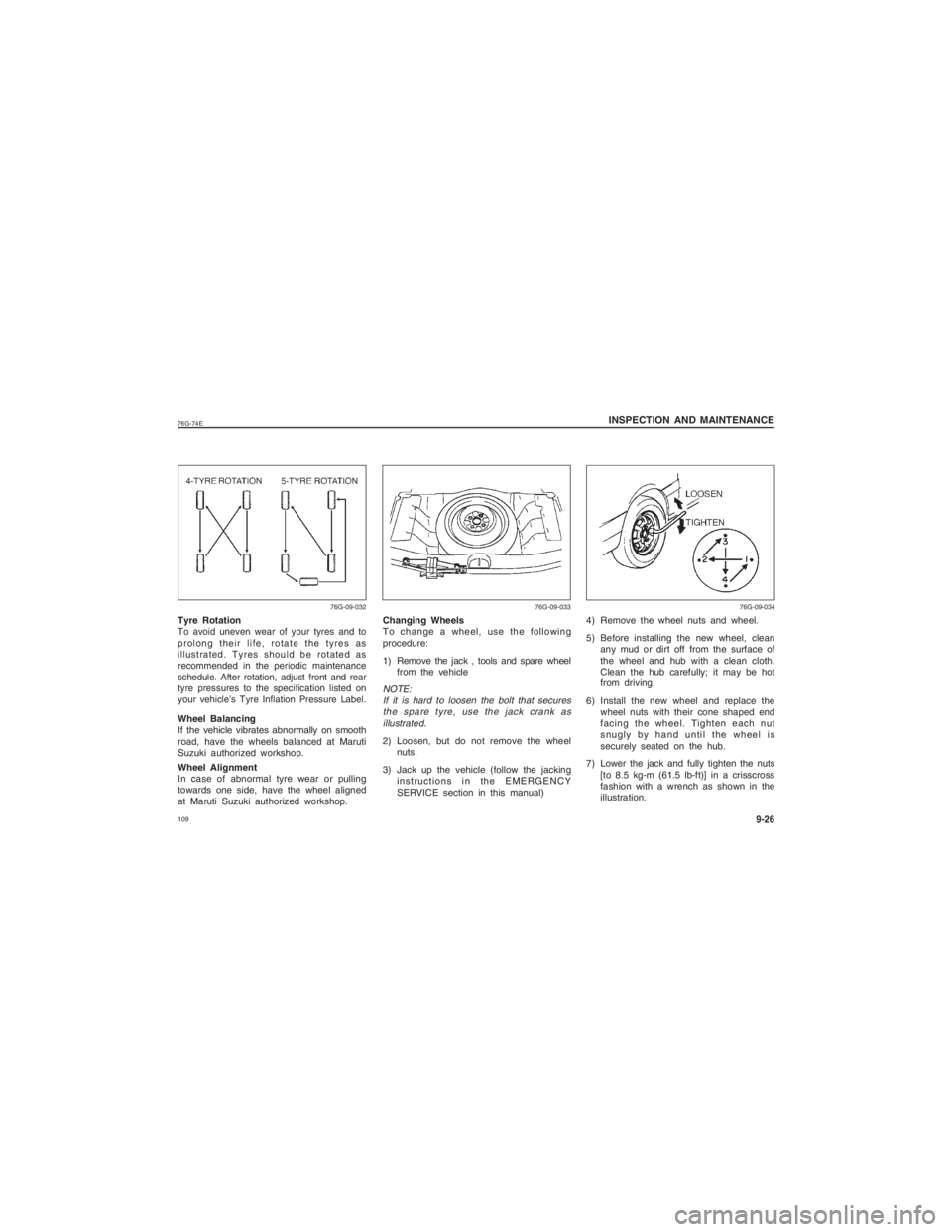
10976G-74E
INSPECTION AND MAINTENANCE
9-26
Tyre RotationTo avoid uneven wear of your tyres and to
prolong their life, rotate the tyres as
illustrated. Tyres should be rotated as
recommended in the periodic maintenance
schedule. After rotation, adjust front and rear
tyre pressures to the specification listed on
your vehicle’s Tyre Inflation Pressure Label.Wheel Balancing
If the vehicle vibrates abnormally on smooth
road, have the wheels balanced at Maruti
Suzuki authorized workshop.
Wheel Alignment
In case of abnormal tyre wear or pulling
towards one side, have the wheel aligned
at Maruti Suzuki authorized workshop.
76G-09-032
Changing Wheels
To change a wheel, use the following
procedure:
1) Remove the jack , tools and spare wheelfrom the vehicleNOTE:If it is hard to loosen the bolt that securesthe spare tyre, use the jack crank as
illustrated.2) Loosen, but do not remove the wheel nuts.
3) Jack up the vehicle (follow the jacking instructions in the EMERGENCY
SERVICE section in this manual)
76G-09-033
4) Remove the wheel nuts and wheel.
5) Before installing the new wheel, cleanany mud or dirt off from the surface of
the wheel and hub with a clean cloth.
Clean the hub carefully; it may be hot
from driving.
6) Install the new wheel and replace the wheel nuts with their cone shaped end
facing the wheel. Tighten each nut
snugly by hand until the wheel is
securely seated on the hub.
7) Lower the jack and fully tighten the nuts [to 8.5 kg-m (61.5 lb-ft)] in a crisscross
fashion with a wrench as shown in the
illustration.
76G-09-034
Page 109 of 139
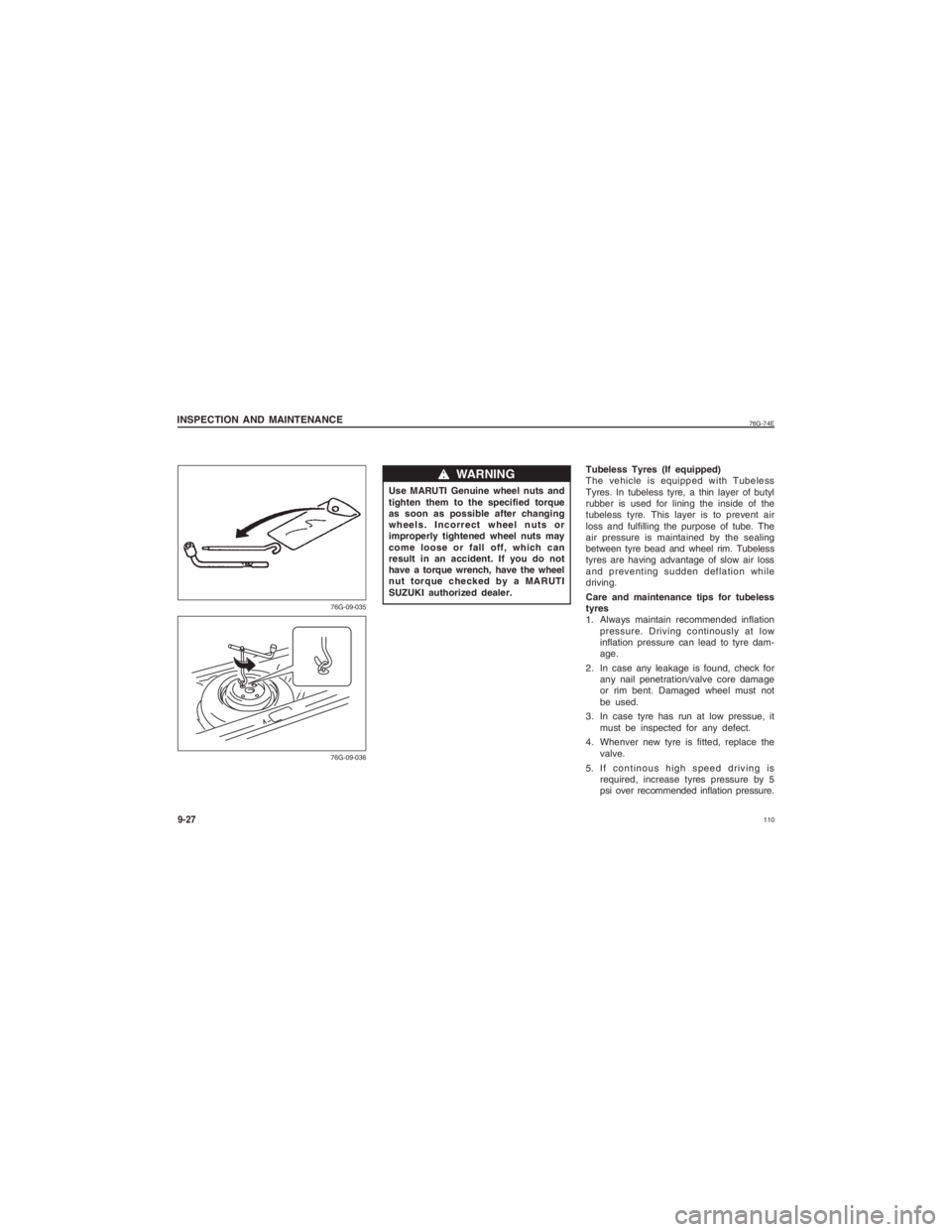
110
76G-74E
INSPECTION AND MAINTENANCE9-27
76G-09-035
76G-09-036
Use MARUTI Genuine wheel nuts and
tighten them to the specified torque
as soon as possible after changing
wheels. Incorrect wheel nuts or
improperly tightened wheel nuts may
come loose or fall off, which can
result in an accident. If you do not
have a torque wrench, have the wheel
nut torque checked by a MARUTI
SUZUKI authorized dealer.
ww ww
w WARNING
Tubeless Tyres (If equipped)
The vehicle is equipped with Tubeless
Tyres. In tubeless tyre, a thin layer of butyl
rubber is used for lining the inside of the
tubeless tyre. This layer is to prevent air
loss and fulfilling the purpose of tube. The
air pressure is maintained by the sealing
between tyre bead and wheel rim. Tubeless
tyres are having advantage of slow air loss
and preventing sudden deflation while
driving.
Care and maintenance tips for tubeless
tyres
1. Always maintain recommended inflation
pressure. Driving continously at low
inflation pressure can lead to tyre dam-
age.
2. In case any leakage is found, check for any nail penetration/valve core damage
or rim bent. Damaged wheel must not
be used.
3. In case tyre has run at low pressue, it must be inspected for any defect.
4. Whenver new tyre is fitted, replace the valve.
5. If continous high speed driving is required, increase tyres pressure by 5
psi over recommended inflation pressure.
Page 110 of 139
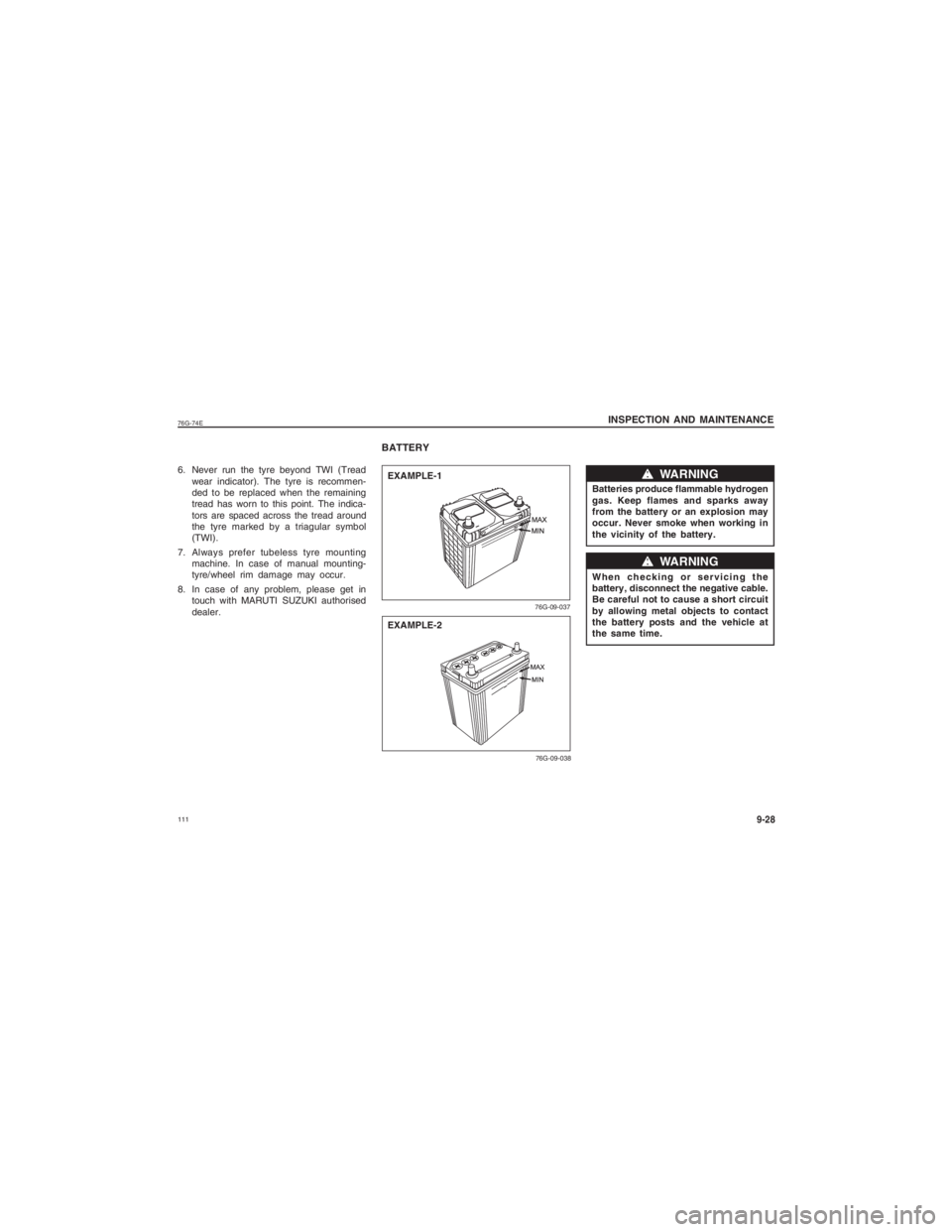
11176G-74E
INSPECTION AND MAINTENANCE
9-28
6. Never run the tyre beyond TWI (Treadwear indicator). The tyre is recommen-
ded to be replaced when the remaining
tread has worn to this point. The indica-
tors are spaced across the tread around
the tyre marked by a triagular symbol
(TWI).
7. Always prefer tubeless tyre mounting machine. In case of manual mounting-
tyre/wheel rim damage may occur.
8. In case of any problem, please get in touch with MARUTI SUZUKI authorised
dealer.
76G-09-037
76G-09-038
Batteries produce flammable hydrogen
gas. Keep flames and sparks away
from the battery or an explosion may
occur. Never smoke when working in
the vicinity of the battery.
When checking or servicing the
battery, disconnect the negative cable.
Be careful not to cause a short circuit
by allowing metal objects to contact
the battery posts and the vehicle at
the same time.
ww ww
w WARNINGww
ww
w WARNING
EXAMPLE-1
EXAMPLE-2BATTERY